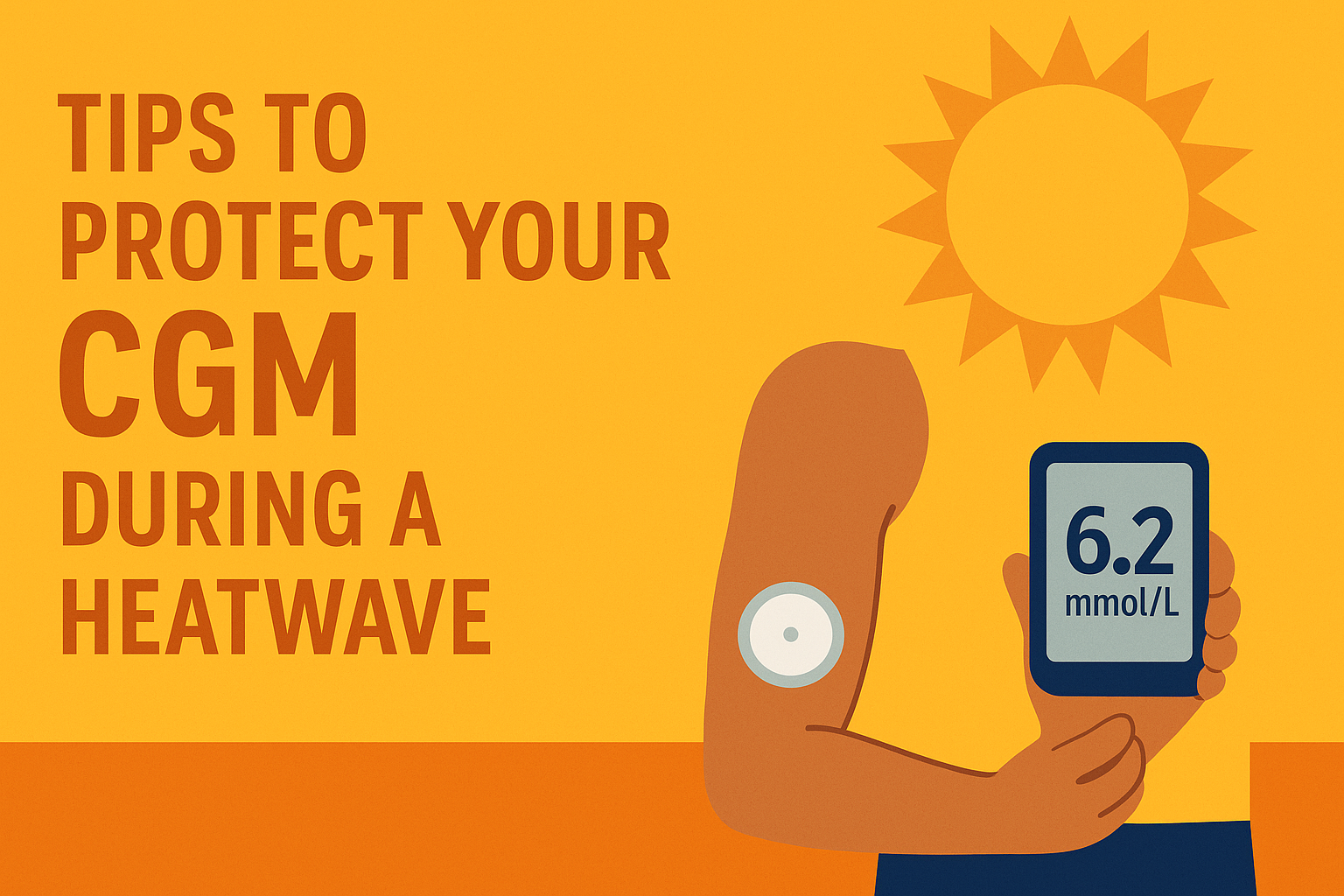
In Part 1 of our blog about the GlucoRx Aidex we detailed the features of this new medtech. Now in this blog, I will give you insights into this CGM based on my own personal experience. I wore this at the same time as a FreeStyle Libre 2 so I could compare the two devices.
You can ignore all the marketing hype put out by the manufacturer, I'll give you insights based on personal experience.
Read on to find out why FreeStyle Libre isn't the only option for type 1s on the NHS. The GlucoRx Aidex is actually a good option for getting the use of a real time continuous glucose monitor (CGM) with some specific advantages over the the FreeStyle Libre (1, 2 and 14-day).
As an aside, I'm not sure how to pronounce the name 'GlucoRx Aidex' but am going to refer to it outloud as 'eye~dex'.
Note: I purchased the GlucoRx Aidex at my own expense and all views reflect on my own personal experience.
Click here for Part 1: GlucoRx Aidex Features Review 

I placed an order on the website, www.glucorxaidex.com, and was impressed that it arrived by tracked delivery with DPD the next day.
As well as the Starter Pack which contains 2 x 14 day sensors and a reusable transmitter, there was a new blood glucose & ketone monitoring kit (GlucoRx HCT), some free samples of a fast-acting glucose gel, diabetic foot cream and a small box of FinePoint insulin pen needles.
Who doesn’t love to open a package and see extra products to try for free? It certainly encouraged me that this would be a good experience.

Before attaching the sensor, I logged on to the online training, the GlucoRx Airdex Academy [https://glucorxaidex.com/courses/glucorx-aidex-academy].
There are 6 modules covering; the components; applying and pairing; tips for calibration; notifications and alarms; arrows and trends; and accuracy.
Each module has an associated quiz to check understanding – usually consisting of 3 questions with a few options for the answer.
Reading the material and answering the quiz took around 35 minutes to complete in total, although I acknowledge that I already had a substantial understanding of the product from authoring our Features Review of the GlucoRx Aidex.
I liked the simplicity and user experience of the training program. I was awarded a certificate which instilled confidence that I was ready to go ahead and attach the sensor.
I would recommend new users of the GlucoRx Aidex to take the time to go through the training prior to application so to understand the system, especially as it does differ from 'flash' devices and other CGMs.

I initially liked the size and shape of the transmitter and it appeared to have a low profile, however once attached to the sensor it appeared to be much more prominent and as I had chosen to place the sensor on my arm it looked as though it wouldn’t be long before it would be knocked off.
I didn’t apply the overpatch included with the starter kit, but wore a Love My Libre armband (magenta pyramid design as shown above) to cover and protect the GlucoRx Aidex. This worked well and so far, after 10 days it is still firmly in place under my armband.
This also helped with covering the underlay which is automatically applied when attaching the sensor. I feel the visual appearance of the adhesive serves to remind users that they are wearing a medical device, in a similar way to that of a Dexcom device, and to a lesser extent, the Libre sensor.

The approved sites are the abdomen and back of upper arms and the instructions state that the abdomen is the preferred site giving greater accuracy.
I chose to wear the GlucoRx Aidex on my arm so that it was comparable to wearing my Libre sensor although I plan to also trial these on my abdomen to see if there is a significant difference. I know that it is a common frustration that Libre users are only recommended to use the back of the upper arms.
The one-piece applicator is similar looking to the FreeStyle Libre applicator, however rather than pushing down to apply it, the Aidex is attached by pressing a small button to release a needle that inserts the filament.
This was not such a smooth process as applying the Libre and I could hear the sound of the spring unloading. There was also slightly more pain. If I was rating this on a pain scale of 1 to 10 with 10 being the highest, I would probably say Libre has a pain-level of 1 and the GlucoRx Aidex a level of 3, although in both cases the ‘pain’ passes quickly, within a minute or two.
Once the sensor is attached the transmitter needs to be clipped over the top. My initial thought was that having 2 separate components seemed a backward step compared to the FreeStyle Libre. However, the Dexcom ONE and G6 both have two parts.
As I had attached the sensor towards the back of the arm I did need to get help to clip the transmitter into place.

My first comparison with my Libre sensor showed that they were in sync, so I was very pleased.
The GlucoRx Aidex is factory calibrated, however, the training academy covers how to calibrate the sensor if preferred, or needed.
Glucose levels can be recorded on the app. To calibrate, users carry out a finger prick test when levels should be fairly stable. It is not recommended to be done more often than once a day and you should not calibrate on the first day of using the GlucoRx Aidex.
Helpfully, the starter pack included a glucose monitor for taking a comparison glucose reading.
I didn't find I needed to calibrate the sensor as readings were usually close to the levels shown on my Libre and certainly within the 20% acceptable tolerance.

Home screen
Usage of the app centres on the main Home screen which clearly displays the current glucose level in the centre surrounded by a circle green band. The trend arrows are shown around the edge of the circle with accompanying description.
The Home screen updates the glucose level every 5 minutes and shows how long ago it was last updated, so actually acts as a countdown until the next 5 minute update.
The screen shows the sensor life which I found a useful reminder.
Graphs
I liked the choice of 3 different views of the graph so that you could see this over a 6 hour, 12 hour or 24 hour period. I often find it frustrating that the graphs on Libre still show my glucose levels for during the night when there's nothing I can do about them the following day and it can sometimes feel that I'm already chasing my tail to get back into my target range with the legacy of the night before still on view.
It's also a positive that the graphs are interactive and that you can press on any data point to see the level at that time.
User interactions

Another positive for me is that the green colouring used on the app is very calm invoking and rather that harsh black lines used on Libre, the dots give the appearance of smoother curves.
As I can pick up my phone at any time to see the glucose level and graph I found it reduced the anxiety and fear I sometimes feel before scanning my Libre for a 'result'.
Trends page
A different page shows the estimated HbA1c, average glucose value and time in range. These measurements are constantly updated so its a good way to keep an eye on how our diabetes management is affecting the longer term.
There is also a graph for ambulatory glucose profile (AGP) - personally I tend not to use this graph but assume healthcare professionals may find it useful.

I have an Apple Watch I was able to see my levels and the graph on this too which I found very useful, although it should be noted that this is not yet available for Android users.
Also, there is no option for this CGM, or any other available in the UK, to connect directly with a watch so the phone always needs to be nearby for it to receive glucose level data.
I can see how this can be particularly useful in environments where you wouldn't want to get out your phone to scan and wanted to check levels discreetly.
There are optional alerts for low and high glucose levels which can be turned on and off and a helpful alert for notifying users of an urgent low glucose level. The urgent low is set at 3.1mmol/L and repeats if there is no acknowledgement. I really liked this feature and found this beneficial over the alarms available with FreeStyle Libre 2.
I'm not sure about the tone of the alarms, lower and more robotic than the Libre alarms, and these did cause some bemusement in our house as we likened them to the sound of a reminder pinging to put on our seatbelt in the car.

My experience was very positive in terms of comparing results with my Libre sensor.
During the first 2 days the glucose levels on the Aidex differed from the FreeStyle Libre occasionally, but were within an acceptable 20% tolerance and the graphs always followed the same pattern on both devices.
My glucose levels would sometimes show higher with the Libre sensor than the GlucoRx but I would suggest this is possibly down to the algorithm used for the Libre which bases levels on a rolling average over 10 minutes.
From day 3 onwards the levels were usually within a range of 0-0.5mmol/L difference which I considered marginal and were largely due to one CGM lagging behind the other, before 'catching up'.
In terms of accuracy, this clearly isn't a scientific test as it would require a much more rigorous process and measurement, but I found the comparisons reassuring and was happy to trust the levels shown by the GlucoRx Aidex.


The reports available when using the GlucoRx Aidex are very limited, however, the essential information is available through the GRX Aidex portal. Again, an advantage of less data means that users and healthcare professionals only need to look at the key information rather than be overloaded with different ways of presenting the same detail.
I know my Diabetes Consultant only really looks at the current data and doesn't have time to overanalyse what's already happened.
Lots of emphasis is still put on a HbA1c result, and it remains to be seen how close this is to the projected level shown by the GlucoRx Aidex as I would need to use this CGM for at least 90 days continuously before a blood test.
HbA1c tests are often seen as a guide to accuracy, however there are many reasons why there can be discrepancies between the two. There's more about the relationship between HbA1c and glucose levels in our blog, What's wrong with HbA1c tests? Click here to read this now.
Data has now shown that time in range may be a better guide than HbA1c, to diabetes management. It's worth noting that there is international consensus that those with diabetes should aim for time in range to be around 70%, where the range is between 3.9 and 10.0 mmol/L.
The pricing for the GlucoRx Aidex is very favourable as in essence you can buy a full CGM for roughly the same price as FreeStyle Libre 1 or 2 which are only 'flash' devices.
The GlucoRx Starter Pack costs £99.85 is currently being promoted which includes 2x14-day sensors and a reusable transmitter. Replacement sensors are priced at £39.95. All costs are plus vat if applicable.
The cost should put it within easier reach than a Dexcom G6 for example, for those self-funding a CGM.
The main negatives to me were:
- Application wasn't as smooth as applying a Libre sensor;
- I felt that have 2 separate components, the sensor and transmitter was a backward step as I had become used to a very quick process in applying a Libre sensor without the need to attach a separate part and 'pair' these to the app.
- Without wearing an armband, this very much felt like a medical product that could easy be knocked or pulled off.
- There is no functionality to allow carers to follow users glucose levels, although reports can be accessed by healthcare professionals.
- Could be considered a more passive view of glucose levelsas data updates every 5 minutes whereas using a Libre you can scan at any time and as many times as you like.
The positives I took from this trial were:
- Ease of picking up my phone to see levels updated every 5 minutes.
- Smooth curves with no gaps (data is back-filled).
- Choice of graph views - I preferred to look at last 6 hours.
- Urgent low alert.
- Easy to use the app interface and interactivity of data on graph. I didn't feel that I was overloaded with data that I needed to manage.
- Reduced stress and anxiety from simplicity of design and usability of the Home screen.
- Ability to see glucose levels on my Apple Watch.
As with other CGMs, a consideration when using a real-time CGM (and Libre 2 with its alarms) is that it relies on bluetooth connectivity. The constant interaction between transmitter and phone app can drain phone battery fairly quickly.
For ease of seeing my glucose levels I left the app open during the day and found that my battery would sometimes run out before the end of the day.
I would also mention that even though all CGM will highlight that users don't need to fingerpick test their blood, in fact if symptoms don't match glucose levels shown by the device, then it is recommended to carry out a fingerpick test for verification.
In conclusion, I did find that the GlucoRx Aidex offered a number of considerable benefits over using a FreeStyle Libre. For me, the most significant of these was that it reduced the stress I sometimes feel from scanning my Libre. I also liked the fact that I could glance at my screen at any time to see the level without any interaction needed.
I still love my Libre but for the convenience the GlucoRx Aidex offers I could learn to love this too - quite easily!
💛💛💛
Thank you for reading. Please do submit comments below if you have any useful feedback on the use of this product.
💛💛💛
Disclaimer
Details and data is correct to the best of the author’s knowledge at the time this blog is published. We do not accept responsibility for any errors or omissions. Information is for guidance only and it is recommended that you confirm specific details and suitability yourself with the supplier, or your healthcare provider.
Love My Libre is not associated or affiliated with any of the aforementioned medtech providers. Content here and on our website www.lovemylibre.com does not constitute medical advice or replace the relationship between you and healthcare professionals nor the advice you receive from them.
The author of this blog has type 1 diabetes and uses the FreeStyle Libre 2 which is provided on NHS prescription. We do not have any affiliate relationship with Abbott, FreeStyle Libre or GlucoRx Aidex.
All third party devices and apps mentioned are registered trademarks of their respective owners.




Ruth Seeds
November 13, 2022
Thank you so much for your sharing this information Samantha. Like you say, the AiDEX website is not very user-friendly so I really enjoyed reading your review and learned a lot from it! My 17-year old was diagnosed T1 just over 6 months ago. We live in New Zealand and unfortunately monitoring products are not funded here. He is currently using Freestyle Libre but will be going away to Uni in the new year so having a continuous system with low alarms will give us all a lot of reassurance. He tried Dexcom when there was an affordable trial offer but we didn’t think that at twice the price of Libre, it was worth the extra money. We particularly found the app disappointing. I just discovered that AiDEX became available here in September so am looking at that. Can I just confirm, you mentioned in the negatives that is no functionality to allow carers to follow users glucose levels. So does that mean there is no partner app for AiDEX? That seems a huge oversight! Thanks again for your amazing review!